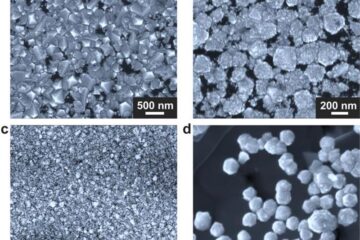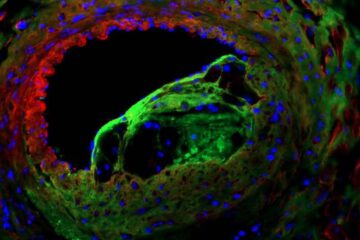Improving the body’s ’homeland security’ against TB

Immune system provides new clue to most life-threatening bacterium
The microbe that causes tuberculosis operates the way a human terrorist would. With minimal resources, the TB bacterium skillfully blends in and gains strength before lashing out unexpectedly. This microbe, which claims more human lives each year than any other bacterial pathogen, even uses its host’s defenses, hiding out in an immune cell called a macrophage.
Now, Rockefeller scientist John MacMicking, Ph.D., has discovered a unique way the immune system can disarm the bacterial offender. If this defense could be strengthened, TB could be brought to biological justice.
Reporting in the October 24 issue of the journal Science, Rockefeller researchers MacMicking and John McKinney, Ph.D., with their colleague from Duke University, Greg Taylor, Ph.D., have identified a new pathway stimulated by the soluble host protein called interferon-gamma that impairs TB’s ability to reproduce itself in mice. Interferon-gamma primarily instructs immune cells to perform different tasks by helping turn on or off certain genes. In the case of interferon-gamma, literally hundreds of genes are induced once its signal is transmitted to the nucleus of the activated cell. Of these, only a few will be responsible for controlling the replication of the TB bacterium. Finding those genes involved in antimicrobial activity against TB is the key.
“We’re looking for immune pathways which could render the TB bacillus vulnerable,” says MacMicking, a research associate in the Laboratory of Infection Biology and lead author of the Science paper. “By learning more about how the immune system successfully operates during infection, we may soon be able to manipulate the host-pathogen relationship in a way which favors us, a somewhat reluctant host.”
MacMicking and colleagues discovered the pathway, called LRG-47, based on clues from another TB-inhibiting pathway called NOS2 and analysis of mouse genes turned on during TB infection. MacMicking is already homing in on the human version of LRG-47. While cellular studies suggest that LRG-47 is involved in altering the bacterium’s intracellular compartment to directly prevent its growth, the precise mechanistic details remain to be worked out. However, the most powerful evidence comes from mice that no longer possess LRG-47 after removal via genetic engineering techniques; these mice become profoundly susceptible to TB infection. The researchers’ findings represent the growing trend in seeking new insights into fighting infections by studying the immune system’s signature response to specific pathogens. Information about each new pathway that is discovered could be translated into new drugs that help boost immune responses to infection.
TB, a hardy bacteria that makes its home during infection by creating its own niche inside macrophages, currently infects one third of the world’s population. Macrophages, which are cells that have specifically evolved to dispose of pathogens by engulfing and chemically destroying them, are the major front-line defense our bodies possess in trying to prevent TB from taking up residence. These cells produce the chemicals — not unlike bleach or other household disinfectants — which kill TB once they have received instructions from interferon-gamma to do so.
Even with interferon-gamma, however, our body doesn’t always succeed in eliminating the bacterium. But interferon-gamma stops TB from replicating, or reproducing itself, inside macrophages. Under these conditions, TB slows in growth until it is latent, or under house arrest, within the body.
“One of the reasons we study the immune response to TB,” says McKinney, head of the Laboratory of Infection Biology, “is to identify better treatments than those currently in use. This will occur only as a result of scientists’ devoting more analysis to the bacteria’s weaknesses and the host’s strengths. That means studying the immune response alongside the bacteria.”
Rockefeller University President Paul Nurse, Ph.D., says: “Not only have MacMicking and McKinney revealed an enticing clue that may lead to much-needed new TB treatments, they’ve carried on their research in the Rockefeller tradition. Their findings continue several aspects of earlier work conducted by Rockefeller scientists, notably James Darnell’s seminal descriptions of the interferon and Jak-STAT pathways, Zanvil Cohn’s pioneering experiments on macrophage immunobiology and Christian de Duve’s Nobel Prize-winning research on the lysosome. Others, such as current faculty members Ralph Steinman and Charles Rice, are similarly interested in finding new ways to employ the immune system in the fight against viral infection and cancer.”
TB largely leads an existence based on stealth. In 90 percent of those infected, it is not life-threatening because the bacteria are under biological house arrest by the immune system. People with latent TB infections do not feel sick, have no symptoms and cannot spread TB to others. While this picture of the vast majority of those harboring the disease seems reassuring, it is misleading. The pathogen can switch from a latent state in any human host if that host’s immune system is weakened.
Normal human aging alone gives TB the possibility of reactivating, disabling and killing any of the two billion people worldwide who are latently infected. When the bug moves out of its latent stage, the person infected is not only at a high mortality risk, but can infect others with TB. An estimated 10 to 15 million people in the U.S. have latent TB.
Treatment for latent infections includes at least three potent antibiotics, but they must be taken alone or in combination, for six to nine months, and often produce toxic side effects. Even in the best health care facilities, patients with TB often balk at the lengthy and often wearying regime. In developing countries with numerous public health challenges, the long treatment and side effects of this treatment are prohibitive. As a result, TB, like staph and other bacterial infections, is becoming more threatening because of growing worldwide multi-drug resistance.
“Tuberculosis is an intractable threat to human health,” says McKinney. “We will never break the chain of infection of tuberculosis the way we did with smallpox, for example. It’s a different kind of bug.” For this reason, McKinney and his colleagues chip away at the sophisticated parrying between the microbe and the human host. Their latest finding puts another brick in the wall between chronic infection with TB and possible immune system-based cures.
“This discovery is exciting because it provides a much sought-after link between immune cell activation and TB inhibition,” says MacMicking. “Previously we’d examined another pathway based on NOS2 but this was not the whole story. LRG-47 opens up a new way of thinking about the problem. It’s the first step in a biologic process which one day could be mimicked chemically and therapeutically through the use of small molecules.”
In 2000, McKinney and his colleagues identified one of the first targets for the immune system arsenal — a bacterial enzyme called isocitrate lyase (ICL) — which allows TB to use fatty acids, instead of sugars, for energy. The enzyme helps keep the latent, or non-dividing microbe, alive. Drug maker GlaxoSmithKline is currently completing a high-throughput screen for ICL inhibitors. An anti-ICL drug could cut off the latent bacteria’s source of energy where the microbe is holed up inside the body.
Given that TB is so difficult to treat with the current crop of antibiotics, drugs that target processes involved during bacterial dormancy or which enhance immune responses against both replicating and non-dividing bacteria may be the best new source of intelligence in the fight against the disease.
Media Contact
More Information:
http://www.rockefeller.eduAll latest news from the category: Health and Medicine
This subject area encompasses research and studies in the field of human medicine.
Among the wide-ranging list of topics covered here are anesthesiology, anatomy, surgery, human genetics, hygiene and environmental medicine, internal medicine, neurology, pharmacology, physiology, urology and dental medicine.
Newest articles

Making diamonds at ambient pressure
Scientists develop novel liquid metal alloy system to synthesize diamond under moderate conditions. Did you know that 99% of synthetic diamonds are currently produced using high-pressure and high-temperature (HPHT) methods?[2]…

Eruption of mega-magnetic star lights up nearby galaxy
Thanks to ESA satellites, an international team including UNIGE researchers has detected a giant eruption coming from a magnetar, an extremely magnetic neutron star. While ESA’s satellite INTEGRAL was observing…

Solving the riddle of the sphingolipids in coronary artery disease
Weill Cornell Medicine investigators have uncovered a way to unleash in blood vessels the protective effects of a type of fat-related molecule known as a sphingolipid, suggesting a promising new…





















